#latomy
Text
Platee Sconfinate
Chi ha frequentato il Liceo Classico, probabilmente, ricorderà una versione tratta da un testo di Plutarco dal titolo Il Teatro di Euripide salva gli Ateniesi prigionieri a Siracusa. Si racconta infatti che dopo la disfatta, inaspettata, dell'esercito ateniese giunto in Sicilia per conquistare le colonie dell'Isola, i prigionieri guerrieri vennero stipati nella latomie: cave di pietra prima, furono poi "convertite" a mega carcere per le centinaia di prigionieri. Fredde d'inverno e torride d'estate, essere imprigionati nelle latomie equivaleva a una condanna a morte: i prigionieri ateniesi furono lasciati morire di fame e di stenti, senza alcuna possibilità di fuga. Plutarco racconta però che i Siracusani, popolo colto e ricco, "amavano Euripide più di tutti gli altri Greci delle colonie" dando ristoro, o addirittura liberando, i guerrieri che ne conoscevano a memoria qualche brano. I sopravvissuti, narra l'aneddoto, quando fecero ritorno a casa, andarono a ringraziare persino il grande drammaturgo.
Questa vicenda ha una parte vera e una falsa: la vera, è che i prigionieri ateniesi davvero morirono di fame nelle latomie di Siracusa. La falsa è che l'aneddoto, divenuto celeberrimo, è appunto falso, e prima di Plutarco ne scrisse uno simile un biografo di Euripide, Satiro di Callatis, autore di molte biografie, quasi tutte perdute, ma di cui è rimasta una parte di quella di Euripide. Tuttavia il nostro Satiro è famoso principe del Metodo Cameleonte, dal nome del peripatetico Cameleonte di Eraclea, che iniziò a scrivere biografie basate a pure combinazioni e deduzioni, ai pettegolezzi e alle cronache scandalose della commedia, e al romanzesco e al leggendario (che non vuol dire che sia sempre fonte inattendibile, ma che va presa con non una ma tre pinze).
Eppure questa leggenda ha ispirato un filologo libano-irlandese, Ferdia Lennon, per scrivere un romanzo, che ho amato tantissimo, che tramite il Mito affronta situazioni davvero profonde, attualissime, usando una scrittura vivace, elettrica e piena di soprese.

Lennon immagina che due vasai disoccupati, il brillante Gelone e Lampo, zoppo e frugale, presagendo che la sconfitta di Atene possa portare alla perdita del grande patrimonio culturale della stessa, si mettano in testa di fare una rappresentazione teatrale con gli atenesi prigionieri nella latomie. Ma non una cosa qualsiasi, bensì un pastiche tra Medea e Le Troiane, le due tragedie leggendarie di Euripide, opere che furono rappresentate la prima poco prima della Guerra del Peloponneso nel 431 a.C., la seconda ebbe la prima ad Atene nel 415 a.C., proprio pochi mesi prima della disfatta di Siracusa. Il progetto è già arcigno, dato lo stato cadaverico degli Ateniesi prigionieri, delle pressioni dei Siracusani e dalle difficoltà nell'allestimento, ma con una serie di imprese al limite dell'eroico, i nostri riescono a farsi fare i costumi, le maschere, le scene e mettono su lo spettacolo. Non vi dico di più, perchè la storia va avanti e di molto, e spero di incuriosirvi con questi altri aspetti per andare da soli a leggere come va a finire.
Innanzitutto la lingua di Lennon, resa magnifica dalla traduzione di Valentina Daniele: peculiare per ogni protagonista, ricca di immagini potentissime, a volte aulica a volte sporca, le invenzioni di traduzione (gli aristo, per definire le classi ricche, o l'uso del mi' ma', mi' pa' per definire colloquialmente i genitori) rende la lettura piacevolissima. La costruzione dei personaggi, soprattutto i principali, il retto e saggio Gelone contro lo spirito intraprendente, al limite del furbesco, di Lampo. Le metafore che quell'impresa offre: il rapporto con l'altro, il ruolo del ricordo, la guerra e le sue conseguenze, persino il ruolo e la potenza dell'Arte come linguaggio universale. Ne esce fuori un libro gioiello, edito tra l'altro da una casa editrice, NN, che nella quarta di copertina ha questo passo: In questo libro c'è un Uomo Nudo. Ciò vuol dire offrire ai lettori storie di uomini che si concepiscono diversi e lottano per questa diversità, lontano da modelli e maschere di padri e pari. C’è, in sostanza, la volontà di stimolare una riflessione collettiva sul maschile, quindi quando troverete questo segnale in copertina, sapete a cosa state per andare incontro.
Che è un ulteriore buon motivo per leggere un libro che mi ha affascinato come pochi.
18 notes
·
View notes
Text
Siracusa
Siracusa (or Syracuse) was the most important city of Magna Graecia. In 413 BC, it defeated Athens. At the height of its power, it was a city of over 300,000. Cicero called it “the greatest Greek city and the most beautiful of them all. “
He had the beautiful part right. Today we took the one hour train ride from Catania to Siracusa. It was a beautiful place to visit on a beautiful day.
There are two distinct parts of the city. Ortygia is a small island, connected by bridges, which is the heart of the old city. The archeological park is in the northern part of the city. We visited both and neither disappointed.
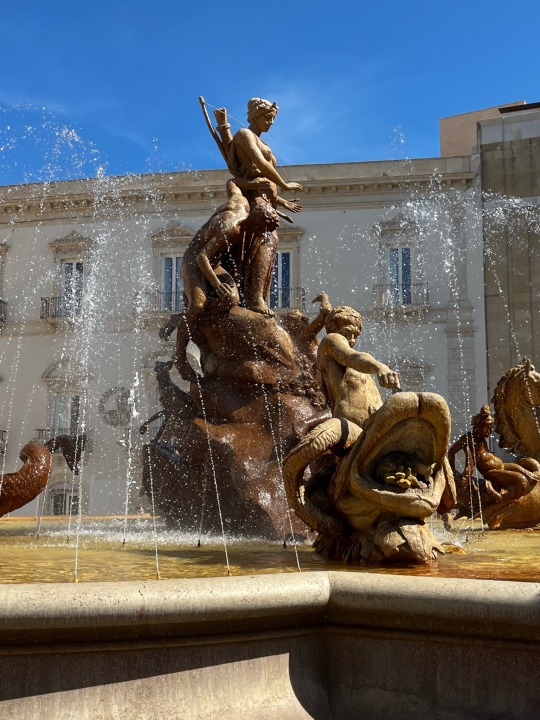
The Fountain of Diana

The Cathedral, which is now my favorite site in all of Italy and about which I will write a separate post.
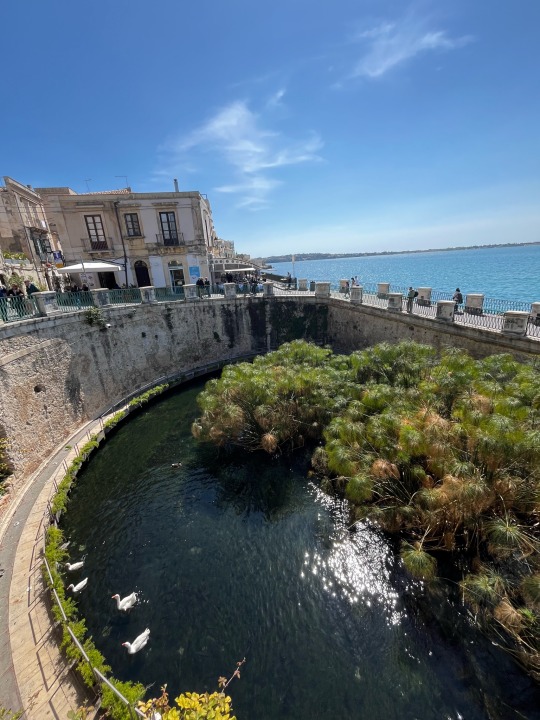
The Fountain of Aretusa, which is really interesting. It is a natural, fresh water spring, right beside the salty Mediterranean.
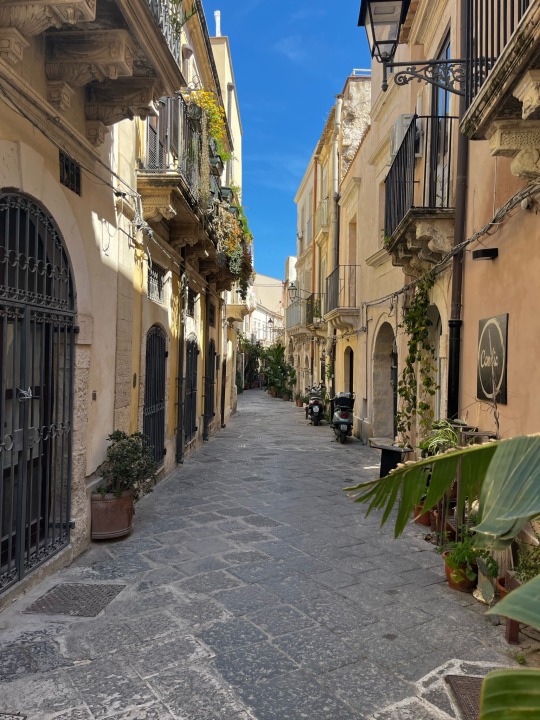
One of many cute streets.

The waterfront.
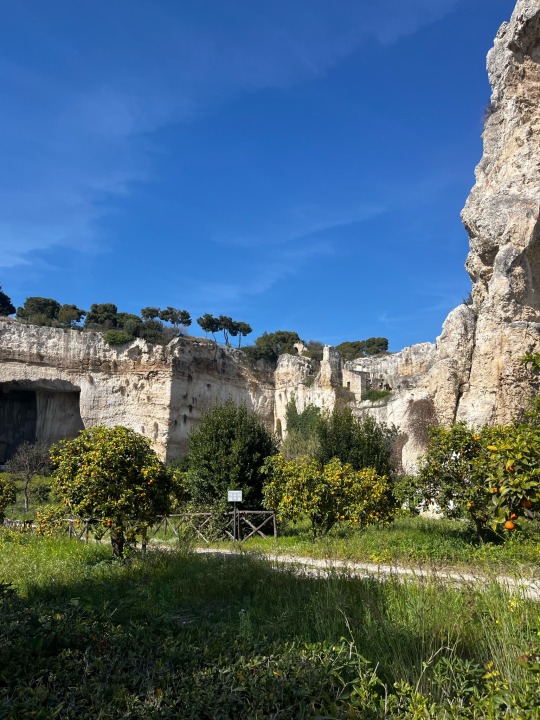
Now the archeological park. These are the latomie, or stone quarries. Huge building blocks were cut out of these cliffs. The center is now a citrus grove but was an ancient prison…prisoners were the workforce. Access to this local stone was Siracusa’s superpower!
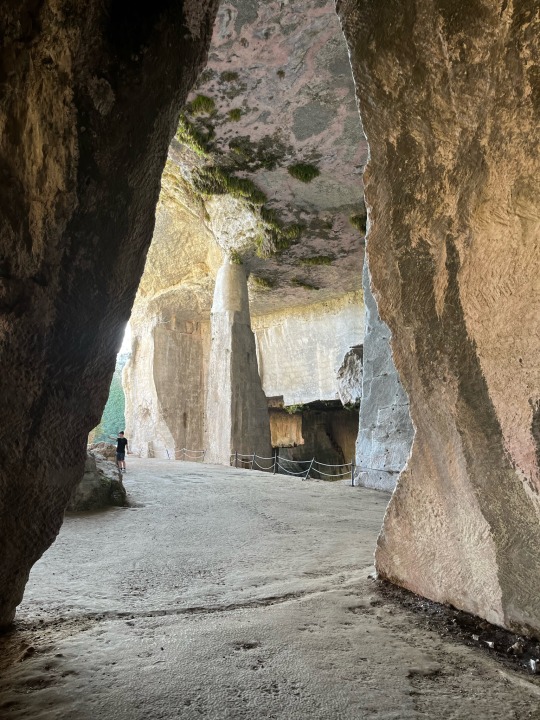
As the stones were removed, huge caves were created. In today’s park, sculptures decorate the walkways and caves. This colossus….
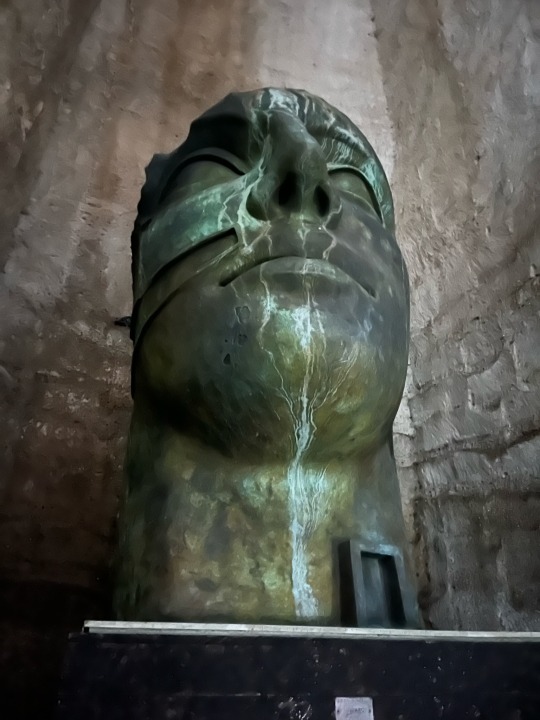
…was in the deepest cave in total darkness. Everyone had their phone flashlights lit! But my phone had no trouble capturing the image in the dark. iPhones are amazing…and so was the colossus!

The Greek theatre is still used today. It has survived because the seats were cut out of the cliff so could not be carried away and reused.
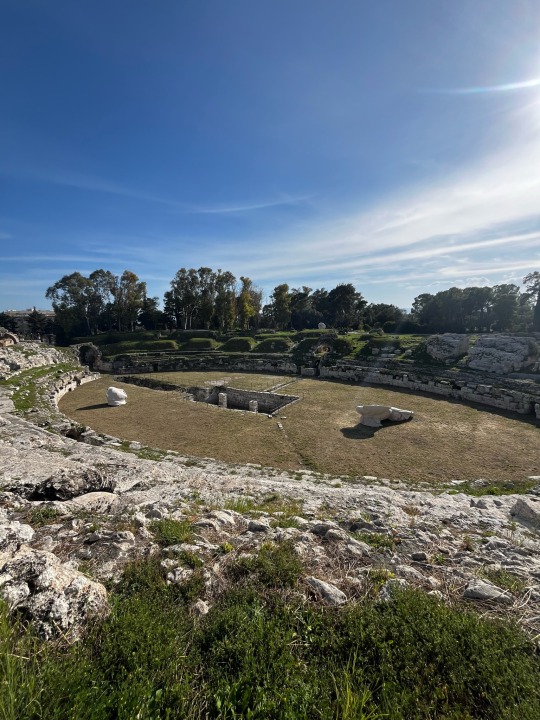
The Roman Amphitheater is less well preserved but still worth a visit. The contests against wild animals ended but the theatre continued to be used for other games until about 400AD
4 notes
·
View notes
Text

i was wondering what felt off about this episode
they were supposed to tell her she could keep where she was from a secret, and explain at the same time that adventurers are allowed to do that because some village heads will sometimes claim the money of their residents for their own as a form of retaliation.
which kind of. lead into The Whole Thing with the latomi villager head. but no, im sure its not important at all........
#wwaffles bein' an idiot#also they added in a thing where she gets weird about her star ranking#like. yeah okay. sure why not.
0 notes
Text
Siracusa, da oggi una nuova collaborazione del Comune con le scuole un viaggio di 1.500 giovani nel patrimonio ambientale e nei musei civici

Siracusa, da oggi una nuova collaborazione del Comune con le scuole un viaggio di 1.500 giovani nel patrimonio ambientale e nei musei civici
Ha preso il via stamattina il progetto “Viaggio nel patrimonio naturale siracusano e nei musei civici cittadini”, messo a punto dal Comune attraverso l’assessorato alle Politiche culturali. Sono coinvolti gli alunni di scuola media di 12 istituti comprensivi e gli studenti di 3 scuole superiori: Brancati, Vittorini, Wojtyla, Santa Lucia, Costanzo, Giaracà, Falcone-Borsellino, Archia, Archimede, Chindemi, Paolo Orsi, Martoglio, Insolera, Gagini ed Einaudi.
I ragazzi, a turno, da oggi fino alla fine dell’anno scolastico, visiteranno 6 siti cittadini di rilevanza ambientale e culturale in un percorso che è, allo stesso tempo, pedagogico e di conoscenza del ricco e variegato patrimonio di Siracusa affinché se ne sentano parte e lo rispettino.
«Oggi – ha dichiarato l’assessore Fabio Granata, che ha accolto al Museo del Cinema e al Museo del Mare le prime scuole – inizia un innovativo progetto educativo per valorizzare e far conoscere ai nostri ragazzi le risorse naturali, archeologiche e artistiche cittadine. Da Villa Reimann al Museo del Cinema, dal Museo del Mare all’Area marina protetta del Plemmirio e, successivamente, dalla Wunderkammer alle Latomie dei Cappuccini, con la collaborazione di esperti e con un approccio interdisciplinare, li metteremo a contatto con questi luoghi per consolidare la consapevolezza e il valore della cittadinanza attiva».
In tutto il progetto coinvolge 1.500 giovani. In questa prima fase, da oggi fino al 7 marzo, il progetto prevede 5 giornate di visite al Museo del Mare e al Museo del Cinema, con 3 scuole per volta. Stamattina le porte dei due siti si sono aperte per gli studenti di Brancati, Vittorini e Wojtyla.
Il progetto, coordinato per il Comune da Giuseppe Prestifilippo, si avvale della collaborazione dei naturalisti Nino Attardo ed Enzo Farinella, del personale dell’Area marina protetta, della Pro loco e dell'associazione SirMuMa....
#notizie #news #breakingnews #cronaca #politica #eventi #sport #moda
Read the full article
0 notes
Photo

Prima visita a #Pantalica e alle #latomie di #siracusa per rinverdire gli studi di filosofia e storia greca. Il tutto in sintonia col libro di #fredericgros #andareapiedi #filosofiadelcamminare suggeritomi dalla docente di #filosofiamorale @mariavitaromeo, della quale ho appena ricevuto la monumentale e prima traduzione di tutte le opere di #pascal. Nel pacco vi ho aggiunto a buon prezzo; #petersloterdijk #statodimorteapparente, #ipoucelebridiscorsidellastoria di #robertamazzini, e di @vittoriosgarbi #viaggiosentimentalenellitaliadeidesideri. #RICCARDOAUTORE #ESTATE2021 #SICILIA (presso Casa Nostrana Club) https://www.instagram.com/p/CR4METXLkCX/?utm_medium=tumblr
#pantalica#latomie#siracusa#fredericgros#andareapiedi#filosofiadelcamminare#filosofiamorale#pascal#petersloterdijk#statodimorteapparente#ipoucelebridiscorsidellastoria#robertamazzini#viaggiosentimentalenellitaliadeidesideri#riccardoautore#estate2021#sicilia
1 note
·
View note
Text
Sicilië | Syrasusa, Archeologisch Park Neapolis
Sicilië | Syrasusa, Archeologisch Park Neapolis
Dinsdag, 15 februari 2022 | Na mijn bezoek aan Basilica Santuario Madonna delle Lacrime is het ongeveer 25 minuten lopen naar het Archeologisch Park Neapolis (Parco Archeologico Neapolis). Het park is ingedeeld in 3 onderwerpen, nl.; Latomie, Grieks Theater, het Altaar van Hiëro II en Romeins Theater.
Syracusa | Oor van Dionysius
De Latomie, de voormalige steengroeven waaruit miljoenen kubieke…

View On WordPress
#2022#Altaar van Hiëro II#Archeologisch Park Neapolise#Grieks Theater#Italië#Jos Saris#Latomie#Oor van Dionysius#Romeins Theater#Sicilië#Syracusa#Syracuse#Travel
0 notes
Photo
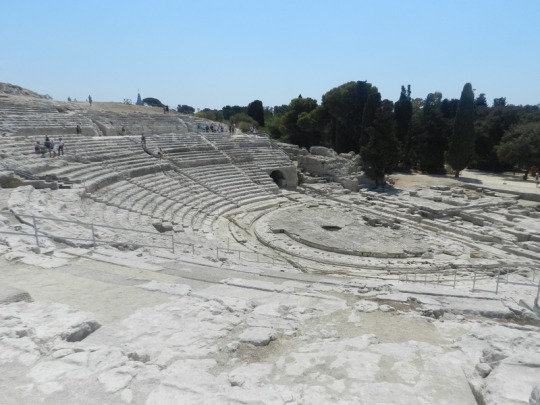



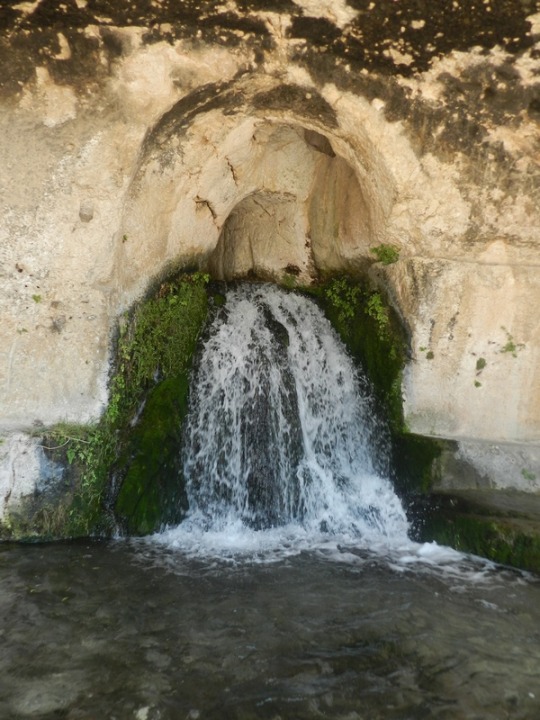
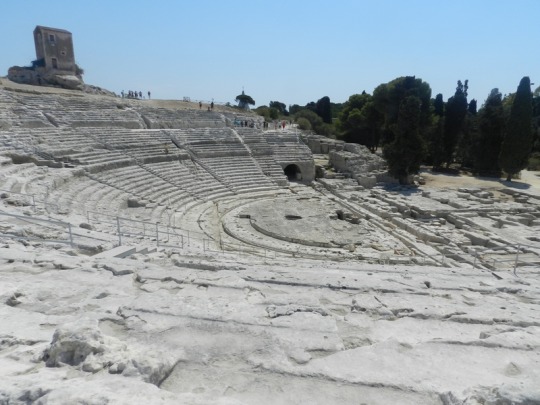




SIRACUSA - IL TEATRO GRECO
Gli stessi antichi greci ci raccontano dell’amore e della considerazione che gli antichi siracusani avevano per il teatro attraverso le parole dei loro storici quando raccontano della sfortunatissima spedizione dell’esercito ateniese contro la ricca e potente Siracusa. Lo storico Teucide impiega due libri a raccontare come 12.000 ateniesi, forti di 220 navi e con la reputazione di aver vinto l’immenso esercito persiano, dopo due anni di guerra furibonda, vennero sconfitti dai siracusani che per i vinti ebbero una ferocia terribile, tanto che dei 7.000 superstiti, solo qualche centinaio riuscirà a tornare ad Atene dopo il pagamento di ricchi riscatti. Alcuni di questi ateniesi però vennero liberati, non dietro al versamento di monete d’argento, ma perché ricordavano a memoria i versi delle tragedie di Euripide e recitandoli, permisero ai siracusani di trascriverli, per poterli poi ascoltare nel loro immenso teatro. Alle spalle del teatro vi sono le Latomie, le prigioni dove gran parte dei prigionieri ateniesi erano stati lasciati morire di fame, di freddo e malattie. Così da una parte del monte si celebrava la bellezza della creatività umana, dall’altra parte si era celebrato il suo aspetto più orribile e crudele in un dualismo tipico delle civiltà umana dove spesso la bellezza risplende tra gli oscuri orrori di guerre e stragi che la rendono ancora più preziosa ed importante.
Così per i vittoriosi siracusani i versi di Euripide valevano, più delle monete che gli ateniesi avrebbero potuto versare per salvare i loro soldati e di ogni altra vendetta sui vinti. Tucidide cita questo aneddoto con enfasi, quasi a ricordare come alla fine i due avversari avevano la stessa cultura, la stessa origine e solo la superficialità ateniese nella preparazione della battaglia e le beghe politiche dei loro capi potevano giustificare una sconfitta così disastrosa, preludio alla prossima perdita di potere della città cara ad Atena.
Ma qui, tra le bianche pietre del teatro greco di Siracusa, questo aneddoto ha un senso diverso perché quelle parole, quelle tragedie in cui gli empi eroi dimenticano le leggi degli dei ed agiscono per atti che meritano la punizione divina, qui trovano una forma, un senso sacrale, una eternità innegabile. Qui dei ed eroi, i cori e le morti, le stragi, le risate o le lacrime, qui tra le bianche pietre, nella prossimità mare, qui le parole che descrivono, raccontano, piangono e imprecano, diventano reali, solide come queste candide pietre. Qui quei versi che salvarono la vita e la libertà degli sfortunati ateniesi, sono ancora vive ed il vento le fa rivivere tra le cime degli alberi che circondano il teatro.
The ancient Greeks tell us of the love and consideration that the ancient Syracusans had for the theater through the words of their historians when they tell of the very unfortunate expedition of the Athenian army against the rich and powerful Syracuse. The historian Teucide employs two books to tell how 12,000 Athenians, strong of 220 ships and with the reputation of having won the immense Persian army, after two years of furious war, were defeated by the Syracusans who for the vanquished had a terrible ferocity, so of the 7,000 survivors, only a few hundred will be able to return to Athens after the payment of rich ransoms. Some of these Athenians, however, were released, not after the payment of silver coins, but because they remembered the verses of Euripides' tragedies and by reciting them, they allowed the Syracusans to transcribe them, in order to then listen the precious verses in their immense theater. Behind the theater are the Latomie, the prisons where most of the Athenian prisoners were left to die of hunger, cold and disease. Thus on one side of the mountain the beauty of human creativity was celebrated, on the other side its most horrible and cruel aspect was celebrated in a dualism typical of human civilizations where beauty often shines among the dark horrors of wars and massacres that make it even more precious and important.
Thus for the victorious Syracusans the verses of Euripides were worth more than the coins that the Athenians could have paid to save their soldiers and any other revenge on the vanquished. Thucydides cites this anecdote with emphasis, as if to recall how in the end the two adversaries had the same culture, the same origin and only the Athenian superficiality in the preparation of the battle and the political quarrels of their leaders could justify such a disastrous defeat, a prelude to the next loss of power of the city dear to Athena.
But here, among the white stones of the Greek theater of Syracuse, this anecdote has a different meaning because those words, those tragedies in which the wicked heroes forget the laws of the gods and act for acts that deserve divine punishment, here they find a form, a sacred sense, an undeniable eternity. Here gods and heroes, choirs and deaths, massacres, laughter or tears, here among the white stones, near the sea, here the words that describe, tell, cry and swear, become real, solid as these white stones . Here those verses that saved the life and freedom of the unfortunate Athenians are still alive and the wind brings them back to life in the treetops that surround the theater.
28 notes
·
View notes
Text

January 31 - St. Peter Nolasco - 1258 A.D
From Chronica Sacri et Militaris Ordinis B. M. de Mercede, per Bern. de Vargas, ej. Ord. 2 vol. in fol Panormi, 1622, and by John de Latomis in 12mo. in 1621, and especially the Spanish history of the same by Alonso Roman, 2 vol. fol. at Madrid, in 1618, and the life of the saint compiled in Italian by F Francis Olihano, in 4to. 1668. See also Baillet, and Hist. des Ordres Relig. par Helyot, and Hist de l’Ordre de Notre Dame de la Merci, par les RR. Pères de la Merci, de la Congregation de Paris, fol. printed at Amiens, in 1685.
Peter, of the noble family of Nolasco, in Languedoc, was born in the diocese of St. Papoul, about the year 1189. His parents were very rich, but far more illustrious for their virtue. Peter, while an infant, cried at the sight of a poor man, till something was given him to bestow on the object of his compassion. In his childhood he gave to the poor whatever he received for his own use. He was exceeding comely and beautiful; but innocence and virtue were his greatest ornaments. It was his pious custom to give a very large alms to the first poor man he met every morning, without being asked. He rose at midnight, and assisted at matins in the church, as then the more devout part of the laity used to do, together with all the clergy. At the age of fifteen he lost his father, who left him heir to a great estate: and he remained at home under the government of his pious mother, who brought him up in extraordinary sentiments and practices of virtue. Being solicited to marry, he betook himself to the serious consideration of the vanity of all earthly things; and rising one night full of those thoughts, prostrated himself in fervent prayer, which he continued till morning, most ardently devoting himself to God in the state of celibacy, and dedicating his whole patrimony to the promoting of his divine honor. He followed Simon of Montfort, general of the holy war against the Albigenses, an heretical sect, which had filled I anguedoc with great cruelties, and overspread it with universal desolation. That count vanquished them, and in the battle of Muret defeated and killed Peter, king of Aragon, and took his son James prisoner, a child of six years old. The conqueror having the most tender regard and compassion for the prince his prisoner, appointed Peter Nolasco, then twenty-five years old, his tutor, and sent them both together into Spain. Peter, in the midst of the court of the king at Barcelona, 608 where the kings of Aragon resided, led the life of a recluse, practising the austerities of a cloister. He gave no part of his time to amusements, but spent all the moments which the instruction of his pupil left free, in holy prayer, meditation, and pious reading. The Moors at that time were possessed of a considerable part of Spain, and great numbers of Christians groaned under their tyranny in a miserable slavery both there and in Africa, Compassion for the poor had always been the distinguishing virtue of Peter The sight of so many moving objects in captivity, and the consideration of the spiritual dangers to which their faith and virtue stood exposed under heir Mahometan masters, touched his heart to the quick, and he soon spent his whole estate in redeeming as many as he could. Whenever he saw any poor Christian slaves, he used to say: “Behold eternal treasures which never fail.” By his discourses he moved others to contribute large alms towards this charity, and at last formed a project for instituting a religious Order for a constant supply of men and means whereby to carry on so charitable an undertaking. This design met with great obstacles in the execution. but the Blessed Virgin, the true mother of mercy, appearing to St. Peter, the king, and St. Raymund of Pennafort, in distinct visions the same night, encouraged them to prosecute the holy scheme under the assurance of her patronage and protection. St. Raymund was the spiritual
director both of St. Peter and of the king, and a zealous promoter of this charitable work. The king declared himself the protector of the Order, and assigned them a large quarter of his own palace for their abode. All things being settled for laying the foundation of it, on the feast of St. Laurence, in the year 1223, the king and St. Raymund conducted St. Peter to the church and presented him to Berengarius, the bishop of Barcelona, who received his three solemn religious vows, to which the saint added a fourth, to devote his whole substance and his very liberty, if necessary, to the ransoming of slaves; the like vow he required of all his followers. St. Raymund made an edifying discourse on the occasion, and declared from the pulpit, in the presence of this august assembly, that it had pleased Almighty God to reveal to the king, to Peter Nolasco, and to himself, his will for the institution of an Order for the redemption of the faithful, detained in bondage among the infidels. This was received by the people with the greatest acclamations of joy, happy presages of the future success of the holy institute. 609 After this discourse, St. Peter received the new habit (as Mariana and pope Clement VIII. in his bull say) from St. Raymund, who established him first general of this new Order, and drew up for it certain rules and constitutions. Two other gentlemen were professed at the same time with St. Peter. When St. Raymund went to Rome, he obtained from pope Gregory IX., in the year 1225, the confirmation of this Order, and on the rule and constitutions he had drawn up. He wrote an account of this from Rome to St. Peter, informing him how well pleased his Holiness was with the wisdom and piety of the institute. The religious chose a white habit, to put them continually in mind of innocence: they wear a scapular, which is likewise white: but the king would oblige them, for his sake, to bear the royal arms of Aragon, which are interwoven on their habit upon the breast. Their numbers increasing very fast, the saint petitioned the king for another house; who, on this occasion, built for them, in 1232, a magnificent convent at Barcelona. 610
King James having conquered the kingdom of Valencia, founded in it several rich convents; one was in the city of Valencia, which was taken by the aid of the prayers of St. Peter, when the soldiers had despaired of success, tired out by the obstinacy of the besieged and strength of the place. In thanksgiving for this victory, the king built the rich monastery in the royal palace of Uneza, near the same city, on a spot where an image of our Lady was dug up, which is still preserved in the church of this convent and is famous for pilgrimages. It is called the monastery of our Lady of mercy del Puche. 611 That prince attributed to the prayers of Saint Peter thirty great victories which he obtained over the infidels, and the entire conquest of the two kingdoms of Valencia and Murcia. St. Peter, after his religious profession, renounced all his business at court, and no entreaties of the king could ever after prevail with him to appear there but once, and this was upon a motive of charity to reconcile two powerful noblemen, who by their dissension had divided the whole kingdom, and kindled a civil war. The saint ordained that two members of the Order should be sent together among the infidels, to treat about the ransom of Christian slaves, and they are hence called Ransomers. One of the two first employed in this pious work was our saint; and the kingdom of Valencia was the first place that was blessed with his labors; the second was that of Granada. He not only comforted and ransomed a great number of captives, but by his charity and other rare virtues, was the happy instrument of inducing many of the Mahometans to embrace the faith of Christ. He made several other journeys to the coasts of Spain, besides a voyage to Algiers, where, among other sufferings, he underwent imprisonment for the faith. But the most terrifying dangers could never make him desist from his pious endeavors for the conversion of the infidels, burning with a holy desire of martyrdom. He begged earnestly of his Order to be released from the burden of his generalship: but by his tears could only obtain the grant of a vicar to assist him in the discharge of it. He employed himself in the meanest offices of his convent, and coveted above all things to have the distribution of the daily alms at the gate of the monastery: he at the same time instructed the poor in the knowledge of God and in virtue. St. Louis IX. of France wrote frequently to him, and desired much to see him. The saint waited on him in Languedoc, in the year 1243, and the king, who tenderly embraced him, requested him to accompany him in his expedition to recover the Holy Land. St. Peter earnestly desired it, but was hindered by sickness, with which he was continually afflicted during the last years of his life, the effect of his fatigues and austerities, and he bore it with incomparable patience. In 1249, he resigned the offices of Ransomer and General, which was six or seven years before his death. This happened on Christmas-day, in 1256. In his agony, he tenderly exhorted his religious to perseverance, and concluded with those words of the psalmist: Our Lord hath sent redemption to his people; he hath commanded his covenant forever. 612 He then recommended his soul to God by that charity with which Christ came from heaven to redeem us from the captivity of the devil, and melting into tears of compunction and divine love, he expired, being in the sixty-seventh year of his age. His relics are honored by many miracles. He was canonized by pope Urban VIII. His festival was appointed by Clement VIII. to be kept on the 31st of January.
Charity towards all mankind was a distinguishing feature in the character of the saints. This benevolent virtue so entirely possessed their hearts, that they were constantly disposed to sacrifice even their lives to the relief and assistance of others. Zealously employed in removing their temporal necessities, they labored with redoubled vigor to succor their spiritual wants by rooting out from their souls the dominion of sin, and substituting in its room the kingdom of God’s grace. Ingratitude and ill-treatment, which was the return they frequently met with for their charitable endeavors, were not able to allay their ardent zeal: they considered men on these occasions as patients under the pressure of diseases, more properly the object of compassion than of resentment. They recommended them to God in their private devotions, and earnestly besought his mercy in their favor. This conduct of the saints, extraordinary as it is, ceases to appear surprising when we recollect the powerful arguments our Blessed Saviour made use of to excite us to the love of our neighbor. But how shall we justify our unfeeling hard-heartedness, that seeks every trifling pretence to exempt us from the duty of succoring the unfortunate? Have we forgot that Jesus Christ our Redeemer, who alone hath bestowed on us whatever we possess, hath made charity towards our fellow-creature, but especially towards the needy, an indispensable precept? Do we not know that he bids us consider the suffering poor as members of the same head, heirs of the same promises, as our brethren and his children who represent him on earth? He declares, that whatever we bestow upon them he will esteem it as given to himself; and pledges his sacred word that he will reward our alms with an eternity of bliss. Such motives, says St. Chrysostom, would be sufficient to touch a heart of stone: but there is something still more cogent, continues the same holy father, which is, that the same Jesus Christ, whom we refuse to nourish in the persons of the poor, feeds our souls with his precious body and blood. If such considerations move not our hearts to commiserate and assist the indigent, what share of mercy and relief can we hope for in the hour of need? Oh, incomprehensible blindness! we perhaps prepare for ourselves an eternal abyss, by those very means which, properly applied, would secure us the conquest of a kingdom which will never have an end. 613
#catholic#catholiscism#christian faith#christian#saint#saints#biography#history#history tag#catholicchurch#church#bible#bibleverse#god#christianity#foolforchrist#godfirst#godisgood#jesus#jesuscristo#jesucristo#jesuschrist#amen#religion#religious
3 notes
·
View notes
Photo

Looking for the stars. #rocks #rocce #Sky #cielo #night #notte #nightsky #cielonotturno #OrecchiodiDionosio #Latomie #myths #miti #tyrant #tiranno #greekmyths #mitigreci #Siracusa #Sicily #Sicilia (presso Latomie Del Paradiso) https://www.instagram.com/p/BzGUrs9IZ3d/?igshid=6e7ternl0tu2
#rocks#rocce#sky#cielo#night#notte#nightsky#cielonotturno#orecchiodidionosio#latomie#myths#miti#tyrant#tiranno#greekmyths#mitigreci#siracusa#sicily#sicilia
0 notes
Photo

Gedeelte van Latomies grotten bij Syracuse, 1778, Museum of the Netherlands
Tekening uit het album 'Voyage en Italie, en Sicile et à Malte', 1778.
http://hdl.handle.net/10934/RM0001.COLLECT.473894
4 notes
·
View notes
Text

Giorgio Sommer (1834-1914)
Siracusa. Latomie del Paradiso
2 notes
·
View notes
Photo

52 Reasons to Love Sicily. #15. Joyful Folk Art. The craftsmanship and tradition of Sicilian carts radiate a rainbow of joy. And today especially, for the Feast of Saint George (April 23), colors and ritual meet, for San Giorgio is the protector of cart drivers and their horses. So, when you encounter a cart, like this one pictured, you'll often see San Giorgio depicted on it (note his image on the bed of this two-wheeler). Painted in the western Sicilian style, this work of art possesses an accent of yellow and more geometric designs that recall the mosaic tiles of Palermo's Arab-Norman Cappella Palatina and Monreale and Cefalù cathedrals. In addition to the painting, the woodwork and the iron works (the axel, etc.), are also an essential part of the craftsmanship. Such wagons where used for centuries to transport goods throughout the island. Drivers were known for their melismatic songs, which were often employed to entertain each other at rest stops and to stay awake while traveling during the night, when it was cooler to protect the fish, fruit, vegetables or other such perishable goods they carried. The designs, which take on a more baroque style on the east side of Sicily, were a way to display how successful a driver was at completing his missions, for the more distinct the designs and the more elaborate the decorations his horse or mule possessed, the more successful one could gather he was. Perhaps it's because he aptly venerated Saint George! #52ReasonstoLoveSicily #experiencesicily #sicily #sicilian #siciliancart #sangiorgio #saintgeorge #folkart #europe #carettosiciliano #carrettiere #sicilia #siciliabedda #italy #italia #sicilyvacation #sicilians_world #ig_sicily #igerssicilia #instasicilia #sicily_tricolors #ig_visitsicily #Sicilia_PhotoGroup #smallgrouptours #traveltogether #authenticsicily #whatsicilyis #viverlasicilia #sicilytour (at Agriturismo Case di Latomie) https://www.instagram.com/p/COA69K4lVNZ/?igshid=1lm27m3ykeag2
#15#52reasonstolovesicily#experiencesicily#sicily#sicilian#siciliancart#sangiorgio#saintgeorge#folkart#europe#carettosiciliano#carrettiere#sicilia#siciliabedda#italy#italia#sicilyvacation#sicilians_world#ig_sicily#igerssicilia#instasicilia#sicily_tricolors#ig_visitsicily#sicilia_photogroup#smallgrouptours#traveltogether#authenticsicily#whatsicilyis#viverlasicilia#sicilytour
3 notes
·
View notes
Text
je serai un cocon de grêle
une fleur de poignards
des ailes rouillées
une oiselle de lames
je connaîtrai l’anéantissement au bout du vent
et je me rappellerai la genèse des barreaux
je valserai dans des latomies d’ages perdus
pour le sel de fer
et les mésanges de chaînes
David Ménard, Poupée de rouille
9 notes
·
View notes
Text
Milano Art Week 23: Tempesta Gallery presenta le macchine sensoriali di Piero Fogliati con un’installazione esclusiva nella chiesa di San Carlo al Lazzaretto

Milano Art Week 23: Tempesta Gallery presenta le macchine sensoriali di Piero Fogliati con un’installazione esclusiva nella chiesa di San Carlo al Lazzaretto.
Piero Fogliati figura poliedrica e grande sperimentatore, ha trasformato “congegni” meccanici ed elettrici in opere multisensoriali e atmosferiche, giocando con luce, movimento e percezione. Immaginava una Città Fantastica abitata da macchine che potessero interpretare i fenomeni della natura e i suoi elementi primari come il sonorizzatore del vento, dei laghi e dei fiumi, la scultura di aria e di acqua nell’acqua.
La fascinazione di Fogliati per il mondo urbanizzato e tecnologico ha sempre fatto da contraltare ai suoi studi sulla trasformazione dell’ambiente e del paesaggio da questa riflessione scaturisce il progetto installativo pensato per la Chiesa di San Carlo al Lazzaretto di Milano, nel vivace quartiere di Porta Venezia, che conduce lo spettatore in una “oasi di poesia” per un momento di abbandono dall'ambiente caotico della cittá e una totale immersione visiva e acustica.
Un progetto aperto al pubblico, che affianca la retrospettiva di Fogliati City Poetry presente in galleria, e accoglie il visitatore in un percorso di quattro opere iconiche che allestiscono lo spazio ottagonale della Chiesa. Reale Virtuale, costituito da un’ampolla di vetro finissimo soffiato a mano posta sopra un proiettore, appositamente costruito dall’artista, al cui interno sono stati inseriti due oggetti ma, come anticipa il titolo stesso, uno di loro è effettivamente reale, l’altro ne è la copia virtuale, equivalente ma speculare. Prisma Meccanico composto da un proiettore di luce sintetica e da un supporto di alluminio a forma di disco dipinto di bianco, verticale, rotante su se stesso ad elevata velocità che raccoglie la luce e la riflette scomponendola in una suggestiva gamma cromatica. Le Latomie costruite da tubi ricurvi di differenti dimensioni in grado di modificare tutti i rumori esterni trasformandoli in un suono continuo sempre variante e coinvolgente.
L’esposizione City Poetry, che presenta un ampio corpus di opere meccaniche di Piero Fogliati, continua nello spazio di Foro Bonaparte, 68 di Tempesta Gallery....
#notizie #news #breakingnews #cronaca #politica #eventi #sport #moda
Read the full article
0 notes
Photo

Ref. 1200
Outstanding Universal Value
Brief synthesis
The site of Syracuse and the Rocky Necropolis of Pantalica on the Mediterranean coast of south-eastern Sicily consists of two separate elements, the historic town of ancient Syracuse and the Necropolis of Pantalica. Together these two components form a unique cultural record that bears a remarkable testimony to Mediterranean cultures from the time of the ancient Greek.
The historic town of ancient Syracuse consists of Ortygia, the historic centre of the city, and today an island that has been inhabited for around 3000 years, and the archaeological area of the Neapolis. Syracuse, the second Greek colony in Sicily was founded by the Corinthians in 743 A.D and described by Cicero as ‘the greatest Greek city and the most beautiful of all’. Syracuse or ‘Pentapolis’ was constructed in five parts, still visible today of which Ortygia is the base of all urbanistic and architectonic developments of successive eras. This area of the property contains traces of the temple of Apollo made in Doric style and the most ancient in Western Greece(6th century B.C.E.), and the temple of Athena, erected for the victory of Gelone over the Carthaginians in 480 A.D., re-used as a church from 6th century C.E. and rebuilt as a Baroque cathedral, in the late 17th century. The Neapolis contains the archaeological remains of sanctuaries and impressive complexes, a theatre, the Latomies, the so-called Tomb of Archimedes and the amphitheatre. Many structures attest to the continuing development of the city through Roman times, from the Byzantines to the Bourbons, interspersed with the Arabo-Muslims, the Normans, Frederick II of the Hohenstaufen dynasty (1197–1250), the Aragons and the Kingdom of the Two Sicilies.
The Necropolis of Pantalica is a rocky outcrop located 40 km. away from Syracuse that contains over 5,000 tombs cut into the rock near open stone quarries. The tombs are spread along a spur over 1200m northeast to southwest and 500m northwest to southeast and most date from the 13th to 7th centuries BC. Associated with the tombs are the remains of dwellings dating from the period of Greek colonisation and other vestiges of the Byzantine notably the foundations of the Anaktoron (Prince’s Palace).
The cultural, architectural and artistic stratification evident in the Syracuse/Pantalica ensemble bears exceptional testimony to the history and cultural diversity of the Syracuse region over three millennia from the ancient Greek period to the Baroque.
Criterion (ii): The ensemble of sites and monuments in Syracuse/Pantalica constitutes a remarkable testimony of the Mediterranean cultures over the centuries.
Criterion (iii): The Syracuse/Pantalica ensemble offers, through its remarkable cultural diversity, an exceptional testimony to the development of civilizations over three millennia.
Criterion (iv): The group of monuments and archaeological sites situated in Syracuse (between the nucleus of Ortygia and the vestiges located throughout the urban area) is the finest example of outstanding architectural creation encompassing several cultural influences (Greek, Roman and Baroque).
Criterion (vi): Ancient Syracuse was directly linked to events, ideas and literary works of outstanding universal significance.
Integrity
The property of Syracuse and the Rocky Necropolis of Pantalica includes all the essential elements that show the Outstanding Universal Value of the property. Each of the three core areas of the property has a substantial buffer zone. Although Syracuse was affected by urbanization and expansion in the second half of the 19th century and even more so in modern times, most of the architectural and monumental developments and structures that date back to its greatest period of splendour are still intact today. All the new developments have taken place outside the recognized areas of historical and archaeological interest.
The most important buildings and structures of the historical centre and the archaeological area (Theatre, Amphitheatre, Monumental Altar of Ieron II, cave of “Orecchio di Dionisio”) are well preserved and the general state of conservation of the majority of the urban and building network has considerably improved due to the protection policies that have been implemented particularly in the last thirty years.
The core area of the Necropolis of Pantalica corresponds to the parts of the site that contain the most important and significant archaeological evidence. Today this area is complete and each element of the rocky villages in the necropolis and in the landscape is perfectly intact and is in an excellent state of conservation.
Authenticity
The authenticity of Syracuse is evident in many of the city’s structures, which retain the same characteristics as during the late Hellenistic period, while other buildings clearly reflect the history of successive cultures over three millennia. The original Hellenistic system and the changes that occurred during the various historical periods have made it possible to clearly distinguish the evidence left in each age and how each culture operated and interacted with the pre-exiting ones.
All restoration works are preceded by meticulous and in-depth research, as well as historical and other subject analyses. They were carried out, as far as possible, maintaining the original characteristics, typologies, building systems and original material according to the most advanced and shared international knowledge in the field of restoration of monuments, under the direct control of technicians and specialist personnel of the Superintendence of Environmental and Cultural Assets.
Despite the fact that the tombs were plundered in different periods, the Rocky Necropolis of Pantalica has a high level of authenticity due to its integrity, good level of conservation and absence of modern developments. It represents an extraordinary landscape as it was in a precise historical period without any significant variations in subsequent times.
Protection and management requirements
The property is protected under the national provisions of the Legislative Decree 42/2004, Code of Cultural Heritage and Landscape, a safeguarding measure that ensures any activity on the site must be authorized by the relevant Superintendence of Environmental and Cultural Assets of Syracuse (peripheral office of the Cultural Heritage and Sicilian Identity).
The areas of the property declared by the State in the past and since 1975 by the Sicilian Region of ‘archaeological interest’ and therefore largely expropriated and registered to the State, are subject to stricter rules for the protection and conservation. The areas registered to the State are managed by the Superintendence Service of Environmental and Cultural Assets of Syracuse. The Region has defined the surface and borders of the Archaeological Park of Syracuse, but this is not instituted as an independent body yet. The Superintendence Service applies the Cultural Heritage Code (Legislative Decree 42 / 2004) and assigns state-owned sites, and operates the tools of government land, protecting and enhancing areas. In addition, the Region proposed a Landscape Territorial Plan that is pending approval. Locally, the General Urban Plan of each municipality, in accordance with the requirements of higher-level tools, identifies the uses of non-state-owned areas and the manner and extent of urban transformation. The activities of the Superintendent are controlled by the Regional Directorate of the Department of Cultural Heritage.
The Department of Cultural Heritage of the Assessorato for Cultural Heritage and Sicilian Identity coordinates the actions within the vast territory, which includes the areas of the city of Syracuse and the Necropolis of Pantalica, through the Superintendence Service of Environmental and Cultural Assets of Syracuse. This Superintendence is responsible for all activities involving the protection for emergency treatment, implementing archaeological research, restoration, enhancement as well as to ensure the use, protection and preservation of cultural heritage. Activities aimed to enhance, promote and protect the landscape are under the responsibility of the Superintendence Service. The Municipalities of Syracuse, Sortino, Ferla and Cassaro have expertise in tourism promotion of the territory and on its roads, at a provincial level.
A Management Plan for the property has been prepared by the Superintendence Service with the involvement of the municipalities. The vision of the Management Plan is to safeguard the cultural heritage and to conserve the stratified urban fabric; to support traditional socio-economic interrelations and cultural production; to improve the quality of life, maintaining mixed uses, increasing security and hygiene, as well as to raise awareness and understanding of heritage resources. Management of the property requires combining conservation processes with the needs of a living and evolving urban landscape.
The necropolis of Pantalica is located in a zone that is distant from all urban areas and industrial facilities, and there are few risks to the site. Syracuse on the other hand is located near a zone of large-scale industries and in a modern urban fabric. This means it is potentially subject to various kinds of risks such as air and noise pollution and illegal development. These risks are currently reduced by environmental protection mechanisms and surveillance.
BY UNESCO
[photos from up to down- left to right: Ear of Dionysius, Catacombs of St. John, Dome aka former Temple of Athena, Necropolis of Pantalica, Greek Theatre of Syracuse]
#unesco#archaeology#history#necropolis#sicily#siracusa#pantalica#province of siracusa#greek sicily#prehistoric sicily#myedit
1 note
·
View note
Photo

✨Le Latomie greche di Siracusa✨ « Tutti voi ne avete sentito parlare, e la maggior parte conosce direttamente le Latomie di Siracusa. Opera grandiosa, magnifica, dei re e dei tiranni, scavata interamente nella roccia ad opera di molti operai, fino ad una straordinaria profondità. Non esiste, né si può immaginare, nulla di così chiuso da ogni parte e sicuro contro ogni tentativo di evasione: se si richiede un luogo pubblico di carcerazione, si ordina di condurre i prigionieri in queste Latomie, anche dalle altre città della Sicilia». Così Cicerone nelle "Verrine" (II 5, 68)🤓 All'interno del Parco Archeologico della Neapolis, proprio in questi giorni, è stato aperto al pubblico un bellissimo nuovo percorso che permette di camminare attraverso la Grotta del Salnitro e quella dei Cordari ⛏🤩 Indossato l'elmetto, sarete pronti per tornare indietro nel tempo ed immergervi in queste cave di pietra, scavate, con le altre attigue, verosimilmente, dal V al III secolo a.C. e testimoni del duro lavoro manuale, di schiavi e prigionieri, al servizio della potenza siracusana⚔️🛡 . © @viaggioasudest . . . . . . . . . . #viaggioasudest #siracusa #igerssicilia #igerssiracusa #italialovers #bestitaliapics #bestsiciliapics #volgoitalia #volgosicilia #volgosiracusa #italiatrip #through_italy #italia360gradi #italytravel #wowitaly #love_united_italia #archaeology #archeologia #ancienthistory #ancientgreece #getoutside #exploremore #landscapehunter #wanderfolk #bestvacations #expediapic #tripmaximizer #travelandlife #forbestravelguide #ig_worldclub (presso Syracuse, Italy) https://www.instagram.com/p/CRbI4p6s6T2/?utm_medium=tumblr
#viaggioasudest#siracusa#igerssicilia#igerssiracusa#italialovers#bestitaliapics#bestsiciliapics#volgoitalia#volgosicilia#volgosiracusa#italiatrip#through_italy#italia360gradi#italytravel#wowitaly#love_united_italia#archaeology#archeologia#ancienthistory#ancientgreece#getoutside#exploremore#landscapehunter#wanderfolk#bestvacations#expediapic#tripmaximizer#travelandlife#forbestravelguide#ig_worldclub
0 notes